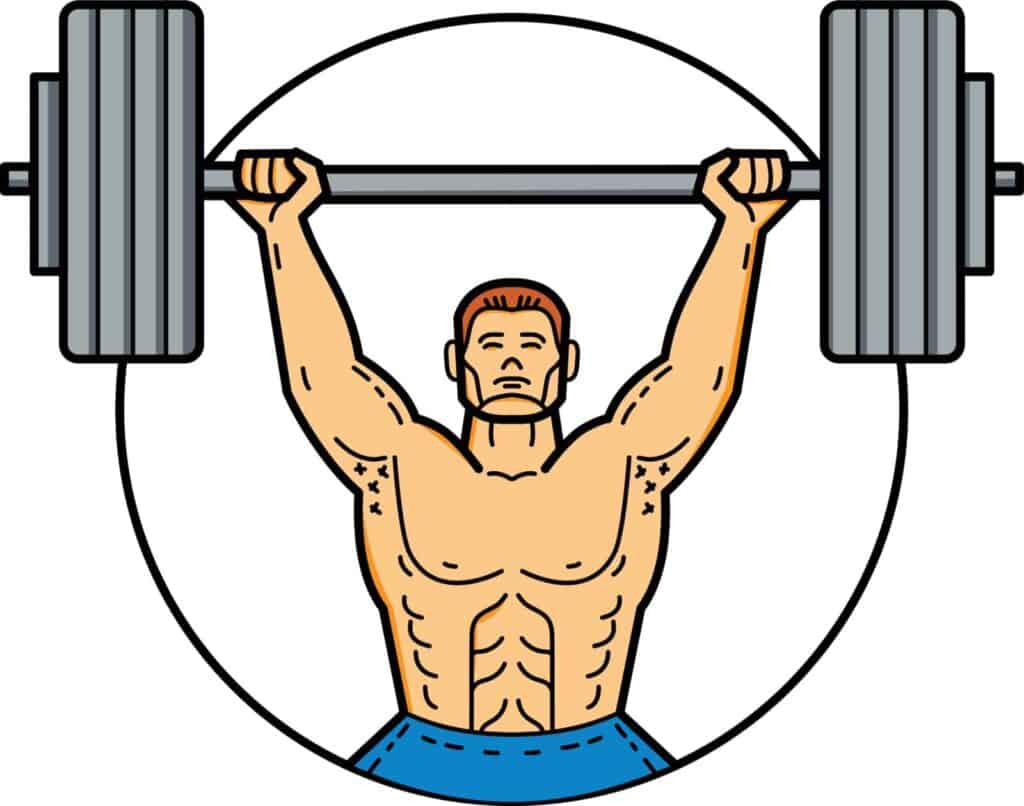What Are Straight Sets?
Straight sets refer to a traditional weight training approach where a lifter performs a set of a specific rep range, rests, and then repeats for several sets keeping the weight load the same. This technique can be used for a number of benefits and is usually used to either improve strength or hypertrophy or sometimes both.

Straight sets often involve warming up with lighter weights to prepare the muscles and even more importantly the joints for the workout.
Warm-up sets typically consist of a set or two of higher repetitions using lighter weights before the lifter begins lifting heavy. When using straight sets the lifter maintains the weight lifted for each consecutive set until they reach their pre-set goal for the number of reps and sets.
For example, if the workout involves the bench press the lifter might perform 4 sets of 5 reps with a heavy weight because 5 is the most they can do keeping such a heavy weight the same.
The goal is to complete the sets as fast as possible while still maintaining proper form. Squats and other lifts can also be performed using straight sets to build strength and muscle mass.
What Are Ramping Sets?
Ramping sets are a type of weightlifting technique that involves gradually increasing the weight of each set while keeping the number of repetitions the same. This technique is commonly used by athletes and bodybuilders as a way to build a high amount of muscle mass.
Ramping sets start with a lower weight and gradually increase until reaching the top set which is the heaviest and also the most difficult set for that particular exercise.

This technique is also beneficial because it enables the lifter to more efficiently warm up their muscles and joints with a lower weight and gradually increase the intensity of the exercise instead of making it too intense too fast.
Ramping sets generally follow a specific ramping scheme which is a way of planning the progression of weights used in each set.
A typical ramping scheme may include several warm-up sets followed by the top set and sometimes even a few straight sets in between.
For example, if performing bench press one may start with a barbell and perform several sets with lighter weights gradually increasing until reaching the top set. The top set would be the heaviest weight lifted for that exercise, usually performed for a particular number of reps.
The number of sets included in a ramping scheme can vary depending on the individual’s goals and training program. Some may choose to perform many sets using a ramping technique until finally reaching the top set while others may only include a few or even a couple of sets before reaching the top set.
The set weight, number of reps, and rest periods between each set can also be adjusted to alter the intensity of the exercise. When done properly ramping sets can be an effective way to build strength and muscle mass.
What is Ascending Loading?
Ascending loading is a training approach that involves starting with a light load and gradually increasing it in each set. This method involves using the ramp-like system of ramping sets to progressively add more weight to each subsequent set of the exercise.
To keep it simple ascending loading is the term that can be used for the method of technique applied to ramping sets. As the sets carry on the load or the weight being used ascends or increases and this is the core basis or your ramping sets.
Straight Sets vs Ramping Sets: Analysis of the Pros/Cons
Straight sets and ramping sets are two different set schemes commonly used in weight training but in two very different ways, especially in bodybuilding. Both set schemes have their advantages and disadvantages.
For beginners and intermediate lifters, straight sets are often preferred because they offer consistent weight and rep ranges that allow for free progression and building foundational strength.
However, for advanced lifters or those seeking to build crazy strength ramping sets can provide a more intense and challenging workout. Increasing the weight in each set of ramping sets helps to effectively stimulate muscle growth and promote strength gains.

However one drawback to ramped sets is that they can cause fatigue and reduce the lifter’s ability to perform at their best on subsequent sets and exercises. It can also pose more of a safety risk since it is greatly more challenging. This is another reason why it is recommended for advanced lifters.
Ultimately the choice between straight sets and ramping sets depends on individual goals, experience, and of course preferences.
While both set schemes can be effective for improving strength and physique choosing the right one can help to maximize results and prevent injury.
Incorporating Straight Sets and Ramping Sets in a Workout Routine
As talked about incorporating both straight sets and ramping sets into a workout routine can be an effective way to improve strength and hypertrophy.
Straight sets are a set scheme commonly used at the beginning of the workout when the muscles are fresh and ready to produce a consistent performance.
On the other hand a ramping set scheme is used to confuse and challenge the muscles in order to promote muscle growth and strength.
Because of this ramping sets are often used as a finisher at the end of a given exercise or workout to really finish off and go the extra mile to fatigue the muscles.
Alternatively, a variation of the ramping set may be incorporated where the weight rather than increased is decreased from the maximum weight used in a ramping set.
Incorporating all these techniques properly into your workout routine helps reduce fatigue and increase the total volume of the lift. While also preventing plateauing in strength gains.
Ramping or Straight Sets for Strength?
Ramping and straight sets are also two popular methods of weightlifting for building strength.
While both methods can be effective ramping is known to be more effective for strength gains. This is because by gradually increasing the weight the body can properly prepare for the heavier lifts without overtaxing the muscles.
The top set or the heaviest work set can then be performed at maximum capacity with a lower risk of injury.
Additionally ramping allows for more volume and intensity to be performed during the last set which can lead to more muscle growth for bodybuilding purposes.
On the other hand straight sets can be more efficient for those with limited time for their strength workouts. It also allows for more consistent lifting as the lifter is using the same weight throughout each set and can easily track their progress over time. However it may not be as effective for building strength as it does not provide the same amount of warm-up and intensity as ramping.
Ultimately the choice between ramping vs. straight sets for strength will depend on the individual lifter’s more specific goals, preferences, and schedule. Both methods can be effective in building strength and muscle but ramping may be the better choice for those looking to maximize their strength gains over a decent period of time.
But Won’t I Hurt Myself If I Start With Heavy Weights?
Many people fear starting with lifting heavy because they believe that it can lead to injury. However, if done correctly lifting heavy weights can be very beneficial. One important aspect is to always warm up properly before starting any heavy lifting.
This can be done through something as simple as stretching to something as taxing as a couple of warm-up sets at a lower weight to gradually prepare the body for heavier lifting. For example, if your goal is to lift 100 pounds for your straight sets, start with 50 pounds for 1 or 2 warm-up sets. This will activate the muscles, increase the heart rate, and warm up the joints to prevent potential injuries.
Additionally form is also crucial when lifting heavy weights. Be sure to lift with proper technique to avoid straining or pulling any muscles.
Finally progressing slowly and gradually increasing weight over time at a steady pace is recommended.
Don’t be afraid to start with light weights and work your way up. In conclusion, lifting heavy weights can be safe and is extremely beneficial when done with proper warm-up, form, and gradual progression.




